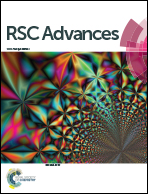Enantioselective toxicity and bioaccumulation of epoxiconazole enantiomers to the green alga Scenedesmus obliquus†
Abstract
Enantioselectivity in environmental behaviour of chiral pesticides has become a subject of growing interest. In this study, ecotoxicity and bioaccumulation of epoxiconazole enantiomers to Scenedesmus obliquus was studied. The acute toxicities of epoxiconazole enantiomers were enantioselective. In addition, enantioselectivity was observed from the determined chlorophyll contents, malondialdehyde contents and antioxidant enzyme (superoxide dismutase and catalase) activities of algae cells after incubation with epoxiconazole racemate or single enantiomers. Moreover, the algae cells treated by the enantiomers of epoxiconazole also showed morphological changes, including plasmolysis phenomena, the disappearance of chloroplasts and nuclei, and the accumulation of lipid droplets and starch granules. In a bioaccumulation experiment, an enrichment in (−)-epoxiconazole was observed during the first three days of algal cell exposure to the racemate; however, (+)-epoxiconazole became enriched after four days of exposure. For the individual-enantiomer treatment, no enantiomerization or enantioselectivity occurred, and the accumulation factor values were higher than those of algae exposed to the racemate. Furthermore, Scenedesmus obliquus had positive effects on the dissipation of epoxiconazole in water.


 Please wait while we load your content...
Please wait while we load your content...